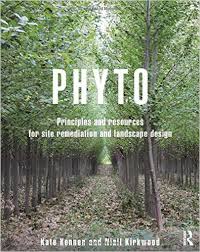All gardeners know that plants make the world a better place. They provide food for humans and other animals; take in carbon dioxide and give off oxygen; and make our yards, our neighborhoods and the earth itself more beautiful.
As if that weren’t enough, Kate Kennen, founder and president of the Boston landscape firm Offshoots Inc., asks plants to do more. She elicits their help to remove pollution from some of the 500,000 brownfields (moderately contaminated former industrial sites) across the country and to keep pollution in check at new building sites.
Kennen has worked on projects all around New England, though not yet in Maine. With Niall Kirkwood, she is author of “Phyto: Principles and Resources for Site Remediation and Landscape Design,” published last year.
Phytotechnology, the broad term Kennen prefers for the type of landscaping she does, is the use of plants to remove or control contaminants in soil or groundwater. Many people use the term phytoremediation, but that refers only to cleaning up areas that are already polluted.
“Phytoremediation works in very small amount of conditions,” Kennen said in a telephone interview. “Often a site is too toxic or the contamination isn’t well matched to the plants.”
More often, the work she does is to prevent pollution in the first place. The idea is to put in plants or other landscape features that keep pollutants from getting into groundwater.
Take, for instance, rain gardens designed in connection with big parking lots; water is directed into the rain garden, where pollutants from the cars can be filtered out. Green roofs work in a similar way.
Another example of phytotechnology? A business would plant poplars, cottonwoods, willows and fibrous-rooted plants (like grasses) in places where a reasonable likelihood of future pollution exists, say gas stations and dry cleaners.
“At a gas station, you would want a landscape that not only would clean up anything they spilled but that would also be sentinel,” Kennen said.
So she would install petroleum-sensitive plants, and if they sickened or died, the business would know that gasoline was leaking. It’s the old “canary in a coal mine” principle.
Removal of pollutants with plants is possible – if you pick the right projects, Kennen said.
For starters, organic compounds are easier to clean up than inorganic materials.
In the 1980s and 1990s some laboratory experiments showed success removing harmful metals like lead from the soil with plants, including sunflowers. But the success of those lab trials did not transfer to actual fields, Kennen said.
It turned out that while the plants could indeed pull up the lead, the lead did not decompose, so then the contaminated plants needed to be disposed of safely.
Plants can break down organic materials in three different ways, Kennen said. The roots can feed on the material, changing it in the soil. The plant can draw the organic pollutant into itself, where the pollutant breaks down when the plant dies and decomposes.
The third method depends on how plants move water from the roots through the stems up to the leaves and into the air.
“Plants move more water than all the rivers in America combined,” Kennen said, a statement I found fascinating.
Many organic materials break down more easily once they are in the air, transpired from plant leaves, so the pollution is ameliorated.
Phytotechnology is complicated, so as the saying goes, you should not try it at home. Hire a professional.
But there are exceptions.
“If you have a scientific kind of mind and make assumptions, there are certain things that are do-it-yourself,” Kennen said.
For instance, if a gardener has a brownfield where kids will not be playing, she could experiment with some of the plants listed in Kennen’s book. “But you have to be sure it is safe to fail,” she added.
With 450,000 brownfield sites in the United States, most in urban areas, making up 20 percent of the nation’s real-estate transfers, according to statistics Kennen cited, the chance that you will have to deal with them may be greater than you might think.
Safe-to-fail phytotechnology could be in your future.
Tom Atwell has been writing the Maine Gardener column since 2004. He is a freelance writer gardening in Cape Elizabeth and can be contacted at 767-2297 or at tomatwell@me.com.
Copy the Story LinkSend questions/comments to the editors.



Success. Please wait for the page to reload. If the page does not reload within 5 seconds, please refresh the page.
Enter your email and password to access comments.
Hi, to comment on stories you must . This profile is in addition to your subscription and website login.
Already have a commenting profile? .
Invalid username/password.
Please check your email to confirm and complete your registration.
Only subscribers are eligible to post comments. Please subscribe or login first for digital access. Here’s why.
Use the form below to reset your password. When you've submitted your account email, we will send an email with a reset code.